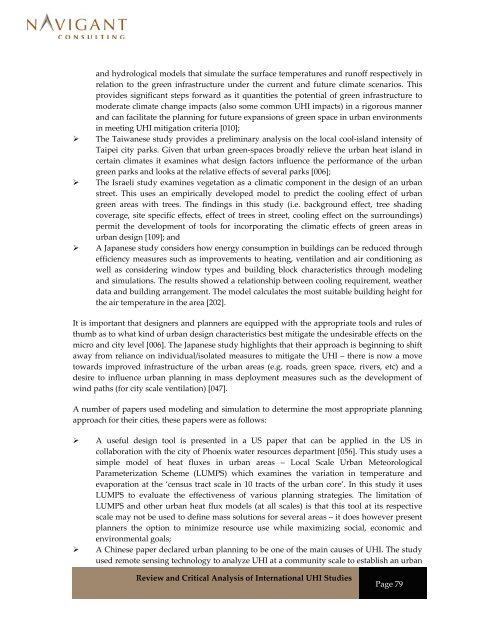Review and Critical Analysis of International UHI Studies
Review and Critical Analysis of International UHI Studies
Review and Critical Analysis of International UHI Studies
Create successful ePaper yourself
Turn your PDF publications into a flip-book with our unique Google optimized e-Paper software.
<strong>and</strong> hydrological models that simulate the surface temperatures <strong>and</strong> run<strong>of</strong>f respectively in<br />
relation to the green infrastructure under the current <strong>and</strong> future climate scenarios. This<br />
provides significant steps forward as it quantities the potential <strong>of</strong> green infrastructure to<br />
moderate climate change impacts (also some common <strong>UHI</strong> impacts) in a rigorous manner<br />
<strong>and</strong> can facilitate the planning for future expansions <strong>of</strong> green space in urban environments<br />
in meeting <strong>UHI</strong> mitigation criteria [010];<br />
� The Taiwanese study provides a preliminary analysis on the local cool‐isl<strong>and</strong> intensity <strong>of</strong><br />
Taipei city parks. Given that urban green‐spaces broadly relieve the urban heat isl<strong>and</strong> in<br />
certain climates it examines what design factors influence the performance <strong>of</strong> the urban<br />
green parks <strong>and</strong> looks at the relative effects <strong>of</strong> several parks [006];<br />
� The Israeli study examines vegetation as a climatic component in the design <strong>of</strong> an urban<br />
street. This uses an empirically developed model to predict the cooling effect <strong>of</strong> urban<br />
green areas with trees. The findings in this study (i.e. background effect, tree shading<br />
coverage, site specific effects, effect <strong>of</strong> trees in street, cooling effect on the surroundings)<br />
permit the development <strong>of</strong> tools for incorporating the climatic effects <strong>of</strong> green areas in<br />
urban design [109]; <strong>and</strong><br />
� A Japanese study considers how energy consumption in buildings can be reduced through<br />
efficiency measures such as improvements to heating, ventilation <strong>and</strong> air conditioning as<br />
well as considering window types <strong>and</strong> building block characteristics through modeling<br />
<strong>and</strong> simulations. The results showed a relationship between cooling requirement, weather<br />
data <strong>and</strong> building arrangement. The model calculates the most suitable building height for<br />
the air temperature in the area [202].<br />
It is important that designers <strong>and</strong> planners are equipped with the appropriate tools <strong>and</strong> rules <strong>of</strong><br />
thumb as to what kind <strong>of</strong> urban design characteristics best mitigate the undesirable effects on the<br />
micro <strong>and</strong> city level [006]. The Japanese study highlights that their approach is beginning to shift<br />
away from reliance on individual/isolated measures to mitigate the <strong>UHI</strong> – there is now a move<br />
towards improved infrastructure <strong>of</strong> the urban areas (e.g. roads, green space, rivers, etc) <strong>and</strong> a<br />
desire to influence urban planning in mass deployment measures such as the development <strong>of</strong><br />
wind paths (for city scale ventilation) [047].<br />
A number <strong>of</strong> papers used modeling <strong>and</strong> simulation to determine the most appropriate planning<br />
approach for their cities, these papers were as follows:<br />
� A useful design tool is presented in a US paper that can be applied in the US in<br />
collaboration with the city <strong>of</strong> Phoenix water resources department [056]. This study uses a<br />
simple model <strong>of</strong> heat fluxes in urban areas – Local Scale Urban Meteorological<br />
Parameterization Scheme (LUMPS) which examines the variation in temperature <strong>and</strong><br />
evaporation at the ‘census tract scale in 10 tracts <strong>of</strong> the urban core’. In this study it uses<br />
LUMPS to evaluate the effectiveness <strong>of</strong> various planning strategies. The limitation <strong>of</strong><br />
LUMPS <strong>and</strong> other urban heat flux models (at all scales) is that this tool at its respective<br />
scale may not be used to define mass solutions for several areas – it does however present<br />
planners the option to minimize resource use while maximizing social, economic <strong>and</strong><br />
environmental goals;<br />
� A Chinese paper declared urban planning to be one <strong>of</strong> the main causes <strong>of</strong> <strong>UHI</strong>. The study<br />
used remote sensing technology to analyze <strong>UHI</strong> at a community scale to establish an urban<br />
<strong>Review</strong> <strong>and</strong> <strong>Critical</strong> <strong>Analysis</strong> <strong>of</strong> <strong>International</strong> <strong>UHI</strong> <strong>Studies</strong><br />
Page 79


